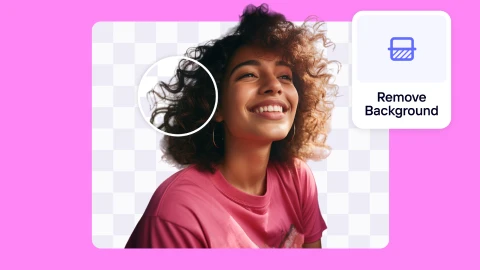How to sell on Depop (2025 guide)
Making your first sale is a major milestone for anyone who sells online.
But it takes time to achieve, especially in a platform like Depop, where there are up to 140,000 daily listings and nearly 2 million sellers — a mix of individuals doing some spring cleaning and small business owners who deal in vintage fashion.
How do you stand out and sell more on Depop?
One word: pictures. It’s easy to neglect the quality of your photos since Depop is primarily a reselling platform. But the truth is, good pictures are among the top things you need to increase sales on Depop.
“The most important step to growing your shop is displaying your stock in a way that makes shoppers take notice. Also, Depop is more likely to feature shoppers on its explore page if you have an eye-catching page.”
— Christie Eccles, top seller on Depop via Business Insider
If you’ve been wanting to sell your clothes on Depop or you already started but want to improve sales, you’ve found the guide you need. I’ll walk you through absolutely everything you need to know about selling on Depop, including how you can explore AI product photography to retouch product photos and elevate your aesthetic.
You’ll learn:
A step-by-step guide for how to sell on Depop
Using pictures to stay on top of your game
How AI can help you with photo editing (+ an editing cheat sheet)
Real examples of Depop sellers who are creative with their photos
Top tips for selling more on Depop
How to sell on Depop
Let’s look at getting started on Depop before diving into the pro tips and using images to drive sales.
Depop is pretty easy to set up. After creating your account, all you have to do is follow five simple steps to start selling your products:
research
source inventory
take great pictures
list your item
and prepare to ship
Your shop’s health depends on your approach to these steps, and I’ll show you how to implement each in a way that can help your shop grow.
Step 1: Research
The first thing you want to do is familiarize yourself with Depop to understand the platform, what people sell, and how the community operates. Review other sellers in your niche, the top-selling items, customer feedback on other brands, Depop’s seller guidelines, and the company’s payment and shipping policies. Research sets the stage for navigating communication, deciding on your inventory, and making the most of the platform.
💡 PRO TIP: If you want to sell trendy items, go beyond Depop and use TikTok for research to stay on top of trends. If you sell fashion items, TikTok is a goldmine for prediction videos on seasonal fashion from industry experts and enthusiasts.
Step 2: Select your inventory
After doing your research, you need to decide what you’ll sell. You can select items by thrifting, cleaning your closet, collecting hand-me-downs from family and friends, or browsing Depop to identify trendy items and what others are selling. Vintage, streetwear fashion, and Y2K are currently the most popular styles on Depop.
Whichever your source, assess your items carefully and aim to choose things worth buying. Your pieces, however old, should be in good condition. For instance, ask yourself: Which would I buy if I came across these two items?

After selecting your items, sort your stock according to type (e.g., pants, shirts, and hats) and condition (e.g., pants: in great condition, good condition, needs mending, etc.). Sorting makes it easier to manage your inventory long-term.
💡 PRO TIP: If you’re selling from home, keep a dedicated ‘Depop Corner’ in your room for organizing all items related to your business on Depop. Here, you can store everything from your inventory to your shipping materials.
Step 3: Take great pictures
Now that you have your inventory, it’s time to prepare how you’ll present them to buyers. As mentioned earlier, pictures are among the foundational pillars for selling more on Depop. Every shot counts!
Here are some hacks for taking great pictures of your items:
Use plain backgrounds. You can use a clean wall, white bed sheets, your floor (if neat), or cardboard paper for your backdrop. The goal here is to reduce clutter, and you can add small elements like flowers to make your pictures aesthetically pleasing.
Take try-on pictures (pictures of the item on you) to help buyers visualize how they can wear what you’re selling. People are more willing to buy your piece when they can gauge its styling and fit. If you sell non-fashion items (like pressed-flower phone cases for instance), pair them with related items (e.g., phones) to give context on how people can use them.
Use natural lighting to enhance the features of your item. Natural light helps reveal the texture and detail of your piece, creating a more three-dimensional and engaging image. It also renders colors more accurately than artificial lighting. And the best part? It is free!
Use the back camera of your phone for your shots (if using a phone). Unlike front cameras, rear cameras capture more light and produce sharper images. They also have more megapixels (e.g., the back camera for iPhone 15 has 48 megapixels while its front camera has 12 megapixels). The more pixel data a camera has, the better quality image it can produce.
Avoid taking mirror pictures as these are unprofessional and unattractive, often including clutter in your background.

Want to make your listings pop and sell faster? Use Photoroom’s background remover for Depop to create clean, eye-catching product photos that stand out in the feed.
Step 4: Create your listing
Apart from taking your images, listing is among the longest stages of setting up your Depop shop. But when done right, it can accelerate your reach and help you land your first sale.
The four focus areas when listing your items include image upload, item description, product information, and your selling price. Here are some pointers for each area:
Upload your images: You can add up to four pictures and one video to your Depop listing, preferably square images in JPEG or PNG formats — the platform requires photos with a 1:1 aspect ratio and 1280 x 1280 pixels resolution. Depop is also testing the ability to add as many as eight images per listing, rolling out the feature to select users for a start. Variety matters too: post flat lays, try-on pictures, a shot of the clothing tag, and even a zoomed-in image that details the material. Also, choose a striking cover image to draw attention.
Craft detailed, engaging item descriptions to prevent the usual back and forth with buyers, give them a vivid understanding of using the item, and help them make informed decisions. Every word in your description is also a potential keyword for reaching more people. So, be deliberate about making them relevant. You’re also allowed up to five hashtags.
Here's a great example of an engaging item description from Loveless Vintage, one of the top sellers on Depop:

Add more information: Add the item’s category, brand name, and accurate condition — transparency builds trust. Enhance your listing by inserting the colors, source, age, and style of what you're selling. Create your shop's policies. Include your location and shipping style. If you offer free shipping and are open to buyers bargaining the price, mention it in your description.
Determine your selling price: Your pricing will depend on several factors, including where you sourced the item, how rare it is, its quality and brand name, how long you’ve had it (if you’re selling something from your closet), and how much time went into making it (if you created the item yourself). Another good pricing strategy is reviewing the price tags of other shops, particularly those that sell similar items. The last thing you want to do is underprice or overprice your item on a platform that provides options to buyers.
As you grow, you can use Depop’s bulk listing tool to create up to 100 listings at once. This feature is available to sellers with a blue tick and those who have made 500+ sales.
Step 5: Prepare to ship
Shipping is a delicate step when it comes to selling on Depop. It affects customer satisfaction and retention and, as an extension of your brand, your reputation. It helps to prepare for shipping before receiving your first order.
For starters, set up your Depop Payments in two super-quick steps:
Verify account: If you’re yet to verify your account, visit the > Selling hub in the Depop app. Select the > Depop Payments banner. Add your full name, date of birth, address, and phone number to activate your Depop balance. You would need an original ID and must be over 18 to have a Depop Payments account.
Add banking details: After you've verified your account, tap the > Seller Hub icon. Select > Payments and > Payment Settings. Then tap > Add bank account to insert your account details and sort code.
PayPal is also a popular payment method on Depop, although the company recently announced removing PayPal from its platform.
Next, use the following hacks to prepare for shipping:
You can choose between paid and free shipping. When opting for paid shipping, consider the shipping costs about the cost of the item purchased. Customers may not be willing to pay for shipping that is close to the cost of the item bought.
Remember that Depop charges a 10% flat fee for every item sold. They also bill a separate transaction fee from the payment provider.
Turn on worldwide shipping (either in your listing page or settings) if you want to sell to buyers globally.
Invest in label printers, label printer sheets, bubble mailers, poly mailers, and a scale (even a simple kitchen scale) to weigh items and determine shipping costs. You can also use old packaging materials from items delivered to you by other brands to save costs and be more sustainable.
💡PRO TIP: Add treats like candies or hand-written notes in orders to delight customers and improve their shopping experience. Also, remember to send tracking numbers to customers.
Check our tool and add white backgrounds to your images
The impact of high-quality product images on Depop success
Pictures are the heart of e-commerce marketplaces. They differentiate you from other sellers and act as attraction machines that pull potential buyers toward or away from your listings.
Here are three main reasons great product images matter on Depop:
Depop has 3.1 million active buyers, over 90% aged below 26. It caters primarily to a Gen Z demographic who are big on visuals. The more striking your pictures, the more you can attract buyers to your shop.
First impressions matter, and high-quality images are the virtual store windows that draw potential buyers into your Depop shop. They convey professionalism, which can help build trust.
Your aesthetic presentation also drives sales. Don’t forget that Depop is a social selling platform designed like Instagram. Buyers are more likely to engage with listings that visually captivate them, which opens the door to potential sales.
Editing images for your Depop listings
Earlier, we talked about taking great pictures of your items. But, honestly, that’s not enough sometimes. You might not have access to a clean background. Maybe you do, but you feel the image needs a little uplift. Perhaps it rains a lot in your city, and the natural lighting isn’t the best, or the back camera of your phone is bad, and you can only make do with the front lens.
How do you cross these hurdles to get sharp, professional product images that sell?
Between the both of us, AI image editors are your best bet. They use artificial intelligence technology to modify and enhance the quality of your photographs, often automatically, which sets them apart from normal photo editing tools. Good AI photo editors are not only fast but easy to use. Where traditional editing tools like Adobe Photoshop are too technical for beginners, newer applications like Photoroom have an easy learning curve, making them fitting for anyone who isn’t a pro at editing.
When deciding what AI photo editor to use, there are a few factors to consider because not all companies use the same approach to train and create their algorithms. Here are the top five things to look out for as a business owner:
Product editing features: Look for an AI photo editor made for businesses. They’re known to offer features like background removal, color correction, and image retouching, which result in high-resolution images that help you stand out.
Consistency in output: Choose a tool that makes applying the same editing settings to different product images easy. On Depop, you want your visuals to be cohesive with your brand’s aesthetic.
Customization and control: The best editors give you control over the depth of your edits. They also offer manual editing tools to make changes as needed.
Batch processing feature: You’ll likely take tons of pictures that require editing. So, go for AI photo editors that offer batch processing. This feature allows you to edit tens to hundreds of pictures at once and save hours of editing time.
Pricing: Consider how much money you want to spend on an editing tool vs the tool’s pricing model. Some editing tools offer free versions with limited features, while others require a subscription or one-time purchase. Go for an application with a pricing plan that works for your budget.
That said, good AI photo editors can be a lifeline for any Depop seller who has little time and money for traditional photography but wants to step up their visual game.
Here are three high-level ways AI can help with your photo editing:
Remove clutter from your photo
As soon as customers land on your shop, you want to delight them with pictures that are laser-focused on the product — which means using images that don’t have a lot happening in them. AI technology is perfect for this. The best AI image editors have a retouching tool for removing unwanted objects and drawing attention to your products. They also make it easy for you to get rid of backgrounds entirely, allowing you to layer your product over different backdrops.

Build an image for your brand
With AI photo editing tools, you can easily change the color of your picture's background. Once you erase the original backdrop, you can select a new color from the catalog provided and apply it to all your product photos, ensuring a consistent brand image. This consistency is vital for brand recognition, especially in a crowded marketplace like Depop.
The colors you use can influence buyers’ perception of your shop. So, consider your brand’s identity, the product’s color, and the mood you’re trying to convey when choosing background colors for your product pictures. Go for subtle colors like brown, beige, or white if you want customers to perceive you as minimalist. If you’re leaning toward a more playful aesthetic, use colors like orange and yellow. It also helps to experiment with different colors to see how they impact the overall look of your images.

Take creative control
You’ve probably heard about generative AI by now and how good it is at creating everything from art to software code. But one of its best, but least discussed, use case is creating custom backgrounds for product images. You can generate unique backgrounds tailored to each product category or the vibe of your pose (if you’re editing a try-on image), which ensures brand consistency and allows you to adapt to changing design trends.
Great AI photo editing tools provide generative AI features that give you control over your image, save you time, and reduce the cost of hiring photographers when you have multiple images to edit.

Try Photoroom - You can download the app for free on your iOS or Android device, or sign up now on Photoroom Web.
Image editing workflow [Cheat sheet]
Okay, AI can help you edit your pictures in all these cool ways. But where do you start?
We’ve created a simple six-step process for editing your images that can save you time. You can also use this workflow with traditional photo editing tools.
Start by setting some standards.
Consistency and style: Clearly define how you want your brand to appear on Depop so that you can take your edits in the right direction and maintain your brand identity throughout your shop.
Editing tool: Select and download your preferred image editing tool. Some require software downloads, while others (especially AI photo editors) either come as web apps or with mobile applications that allow you to edit on the go. It’s okay to explore different tools before settling on one.
Customization: It’s good practice to customize edits for different product types to save time in the future. But you can do this after editing several images and getting a hang of the tool you’re using.
Prepare pictures: Snap your pictures and save them in an accessible device before editing. Remember to take professional-looking pictures by using clean backgrounds, taking try-on pictures, focusing on the right angles, using natural lighting if the weather permits, taking advantage of your back camera, and avoiding mirror pictures since they come off as unprofessional.
Apply enhancements: Open your chosen image editing tool and start applying edits like resizing, adding shadows, color correction, adding your logo, making transparent backgrounds, and retouching to improve lighting and remove unwanted objects.
Optimize files: Save edited images in the appropriate format and resolution. Keep Depop’s image guidelines in mind. Again, the platform requires square images with a 1:1 aspect ratio and a resolution of 1280 x 1280 pixels. Most image editors allow you to save your files as JPGs or PNGs, the relevant file formats for Depop.
Name and organize photos: Give your files descriptive names before saving them on your device. Clear naming helps you achieve two things: It makes it easier to access your files and helps improve your ranking on Depop, which can boost traffic to your shop. Also, organize your images in folders according to a specific item to be listed (e.g., white winter jacket pictures) or the item’s category (e.g., all winter jacket collection).
Keep backup files: Keep versions of the original and edited pictures to prevent data loss. You can back up your files on different devices or by using cloud-based storage platforms like Google Photos, Dropbox, and Microsoft’s OneDrive.
When you have many pictures to edit, consider using automation features like batch processing and preset settings available in most image editing applications, to make editing faster and easier.

Best practices for editing images for Depop
Here are the top best practices to help you edit and optimize images for your Depop listing.
Experiment: Play around with different editing features to discover what works best for your products.
Keep a balance: Maintain a balance between enhancing your product images and preserving their authenticity. Excessive retouching can misrepresent your product's condition, which is bad for your reputation.
Batch edit: Use editing tools powered by AI technology to automate repetitive editing tasks and streamline your workflow. You'll find the batch-processing feature of these tools helpful if you have dozens of pictures to edit.
Focus on seasons: Use seasonal colors to help create a sense of relevance and appeal to potential buyers. Mark big holidays (e.g., Christmas) that resonate with your target audience in your calendar. Note the climate conditions of different seasons – spring, summer, fall, and winter. Set yourself apart as a trusted brand for customers' needs.
Review: Cross-check your edited images for errors before publishing. Check that the product is in focus, the background is consistent and free of distractions, and the colors of the image are accurate and match the original product. Make sure that the image is clear and not pixelated. If you insert your logo, take another look to be sure it’s well-placed. Ask a friend to review and provide feedback on any errors you might have missed.
Optimize for speed: Optimize images for fast loading times, especially on mobile devices, since 87% of young adults (the core demographic of Depop buyers) use their phones for shopping. You can do this by compressing images to reduce file size, resizing images to fit the required dimension on Depop, and using the right image format.
Implement feedback: Request, listen to, and implement customer feedback on your product images. Their preference can help you adjust your editing strategy for better results in the future.
Perform A/B tests to optimize performance on Depop. To do this, upload two listings of the same product at different times and compare which attracts more customers. Remember to change only one element in each image, such as the cover photo, while keeping the product and description the same. This way, you can accurately measure the impact of the change and determine what works best. In some cases, you’d need to modify the description of an item you’re listing for the second time, to accurately represent its current condition.

Three Depop sellers to inspire your product images
In this list, I’ll highlight some Depop sellers who upload stunning pictures and how their content helps them stand out. Hopefully, their work will give you some ideas for your next product image!
Fifi’s Closet
Vintage fashion has a special place in Gen Z's hearts, and Fiona Short has been delivering on that since launching Fifi’s Closet in 2015. The U.K.-based seller currently provides sustainable jewelry to her 125,000 followers and has sold nearly 7,000 items, including to fashion model Bella Hadid.
What she does well with images: Fifi’s Closet is a visual representation of the word, vintage. Her items are simple but distinct, and she captures these unique qualities in her shots. While she primarily uses an off-white, clutter-free background for her images, she cleverly includes pictures of products layered over lifestyle backdrops that give her shop a historical charm. She also captures her pictures from multiple angles, giving customers a chance to carefully asses each item before adding it to their cart.

Campervan Vintage
When you visit Scott & Will’s Campervan Vintage, you’re immediately greeted with an eclectic collection of fashion items — everything from coveralls and travel bags to platform trainers and western-style shirts. Each piece is vintage, and the brand, which the duo launched in 2018 to save up for an electric vehicle, emphasizes texture and material in their style, stating on their shopfront that “We love contrasting corduroy, leather and linen fabrics.”
What they do well with images: Scott and Will’s pictures are simply stunning. They lean into lifestyle pictures — the candid poses, the gazing into the distance, the sitting with one leg stretched — all of which create a feeling that the items are alive and help buyers envision how they’ll wear their picks. Their images are also well-edited but not overly polished, maintaining the authenticity of each item while appealing to customers’ affinity for beauty.

Christie’s Cupboard
Christie's Cupboard is a treasure trove of Y2K and designer clothing. U.K. and Australia-based, Christie Eccles launched her Depop shop to supplement her part-time job. She has since turned it into her full-time business, selling more than 10,000 items and amassing over 100,000 followers on the platform.
What she does well with images: If anyone knows the power of good images on Depop, it’s Eccles.
“Using a good camera and natural light or studio lights to capture your stock with clear photos makes a huge difference,” the top seller told Business Insider in an interview.
Looking at her shop, you get the feeling that each item is casual but bold, playful but elegant. Maybe it’s the simplicity of her background. Maybe it’s how striking her cover images (most of which follow a consistent style) are. Regardless, it’s clear that she understands her target audience and how to communicate her brand’s essence.

Additional tips for selling on Depop
Do you want to become a top seller on Depop? In addition to uploading great pictures and writing detailed descriptions, here are seven more tactics to increase your chances of having a successful Depop shop.
Be size-inclusive. Not many brands cater to plus-sized people, and you can stand out by offering a wide range of items for different body sizes.
Show up consistently through your listings and interactions. Buyers take you more seriously when you post regularly and respond quickly to messages.
Engage kindly with customers and provide them with every relevant information that’ll make their shopping experience smoother.
Promote your shop on social media platforms like TikTok, Instagram, and YouTube to reach more buyers.
Follow others and like their products to get more eyes on your page. Search for items within and outside your niche to find other business owners to engage with. You can also join the r/Depop community on Reddit to interact with other sellers.
Frequently refresh your listings. Depop shows buyers newly posted items, and since other sellers use the same hashtags you’ve inserted into your descriptions, chances are that your older posts may not reach as many people unless you update their descriptions to push them to the top of your page.
Remind customers to leave reviews, not only ratings. Social proof is a valuable currency in the e-commerce landscape. The content of a buyer’s review matters more than their rating of an item. Shoppers want to understand how others feel about the product and seller, and they can only learn that by reading reviews.
Implement the best tips to increase Depop sales
Depop can be intimidating at first. You’ll find top sellers with thousands of followers, those who have invested years into perfecting their visuals, and business owners with dozens of stocks who upload daily and attract tons of customers to their shops. But remember that everyone starts somewhere.
You can build your way to the top by researching the platform, picking items of value to sell, taking excellent pictures that align with your brand’s message, writing engaging product descriptions, and showing up frequently. Don't get discouraged if no one buys your clothes right away, and experiment with different things (like your images, descriptions, and communication materials) to know what works for your business.
It’s been great fun diving into how to sell on Depop, and I hope you picked up one or two tips from this post. If you want to explore AI photo editing, check out our other articles:
Selling on Depop FAQ
What do I do if someone steals my photos on Depop?
Email the customer service at Depop to report the seller for copyright infringement. It’s against Depop’s terms and conditions for someone else to pass your images as theirs. So, the platform will take down the listing. You can also take the same steps if the person steals your photos and uploads them to a different ecommerce platform.
To protect yourself in the future, add your logo or a little signature to your image. You can use AI editing tools like Photoroom to watermark your images as you edit.
How do I sell on Depop as a beginner?
Follow these steps to get started on Depop:
Name your shop and create your account
Do your research to familiarize yourself with the Depop community
Select your inventory by thrifting, cleaning out your closet, or taking hand-me-downs from family and friends
Take neat pictures of your items and use a photo editor to enhance them
Determine the selling price of your item
Verify your account and enable Depop Payment
Visit the Sellers Hub on Depop to create your first listing
Write detailed product descriptions
Prepare your shipping items (like poly mailers, label printers, and a scale)
How do I sell on Depop without PayPal?
Use Depop Payment, the native payment service on Depop. The company recently announced that they’ll be sunsetting PayPal from their platform, and sellers would be required to use Depop Payments for all transactions.
Can I add more than 4 pictures to a listing on Depop?
Depop allows 4 uploads per listing. However, the company is testing an update that permits up to 8 photos in a listing. The feature is currently available to a select group of sellers, and you can check your listing page to see if you’re among them.




Design your next great image
Whether you're selling, promoting, or posting, bring your idea to life with a design that stands out.















